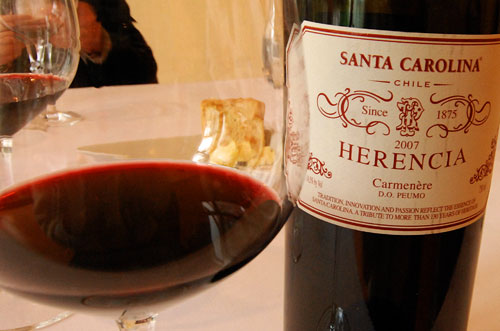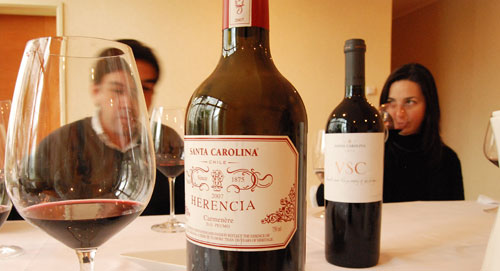
One of the lesser known classic wineries in Chile, alongside heavy hitting names like Concha y Toro, Cousiño Macul, and Santa Rita, Santa Carolina is celebrating 135 years as a winery. Have you heard of them? Probably not until now. Although it’s been a player in the local market for some time, its wines were more mass-driven, and for my taste, didn’t really offer up anything all that compelling—until recently.
A top-down reorganization in the winemaking, wine styles, selection of vineyards and varietals, viticulture management, and even marketing has really caused Santa Carolina—and all its brands—to do a 180-degree turn. Quality-driven with an eye to attractive prices. An intimate understanding of new their terroirs and why they’re pioneering them. There’s an air of rejuvenation, of innovation, and, well, it shows in the wines.
Several months ago, I went to a marathon tasting of all their wines and brands (40-odd wines, do I remember after all of that?). What struck me was this shift that had been applied across the board from reserve to their icon wine, Herencia. It’s a compelling project spearheaded by the vision and savvy know-how of the head winemaker, Andrés Caballero. In the coming weeks, I will be profiling several of their wines and sharing my tasting notes (assuming I can decipher them, by the end of 40 wines that was a challenge…). To jump start this, let’s check out their ultra-premium Carmenere, Herencia, a trend we’re seeing in Chile among wineries looking to exalt the humble flagship grape, Carmenere, to god-like dimensions.
Santa Carolina Herencia Carmenere 2007 (Peumo)
In Spanish, Herencia means heritage and this wine, fittingly, is a testament to the history of the winery—both the old and the new identity they are forging. Made from 85% grapes in La Rinconada vineyard in the Cachapoal Valley (hot spot currently for Carmenere growing) and 15% from Los Lingues a little farther south in Colchagua, this is a lush style Carmenere typical of these areas. Carmeneres from these regions tend to be deep, dense, concentrated, and show the typicity of the fruit when it’s ripened (slowly) with tons of sun.
This wine is a beauty. Swish and swirl and stare in your glass at the deep ruby color that radiates pomegranate rays towards the sides of the glass. Take a whiff and breathe deeply. It’s rich. Those dark, juicy fruits like ripe black cherries and plums that would dribble down your chin if you bit into them. Behind the fruit is a humming of spices like clove, maybe a hint of tobacco. The barrel is obviously there.
Say “ahh,” that is, take a sip. This is a big wine, like many reds from Chile, at 14.5% alcohol. Blame it on all the sunshine and Carmenere—the last grape to be harvested in late May—is certainly a sun worshipper to get to its ideal ripeness. This wine in the mouth is complex and has smooth tannins backed with fresh acidity. It’s not a girly wine, though. This could stand up to everything from some delicious rare lamb chops to grilled salmon. The overall sensation is one of balance and elegance, although the texture and deepness of flavor read like a decadent bonbon. After swallowing, the flavor lingers and lingers and lingers with notes of blackcurrant and those dark notes again. Delicious, although it was so dense my sensation is that after a glass or two my palate may need to go to a less-intense wine. Well, there’s only one way to know—run an experiment at home. Have a good weekend everyone!













